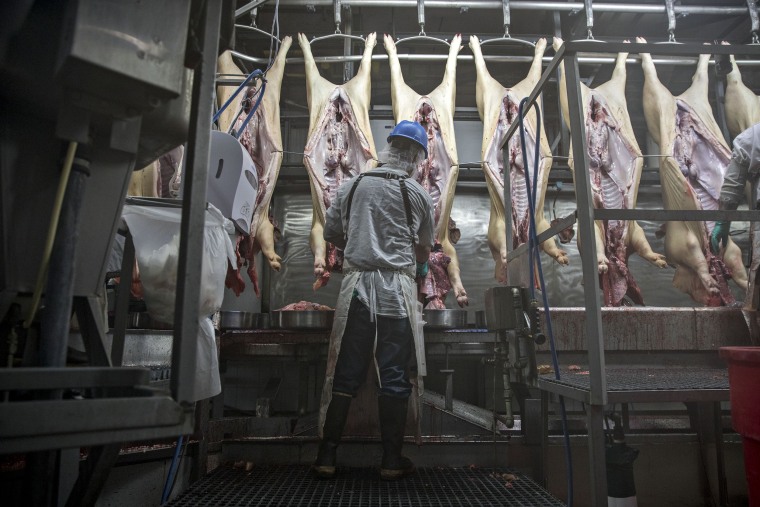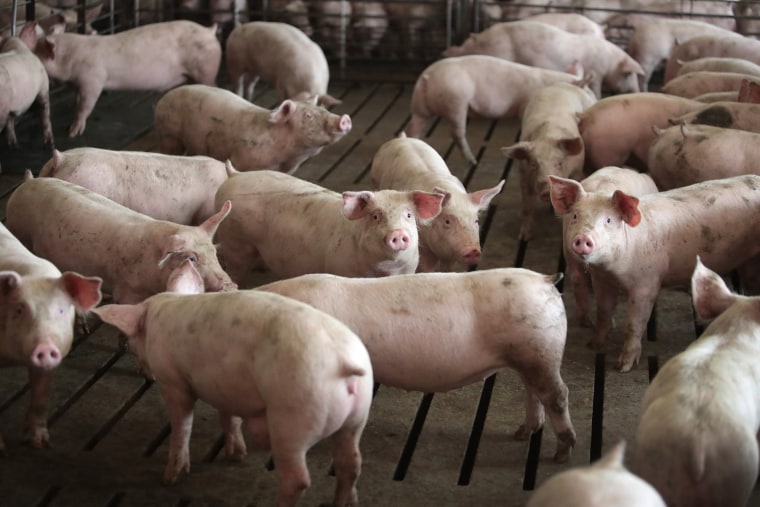Meat processing plants have shut down across the United States as the coronavirus has spread among workers, creating enormous bottlenecks in an inelastic supply chain. The result has been empty shelves in grocery stores and millions of pigs that are all fattened up with nowhere to go.
Facing rising costs and increasingly cramped conditions for their herds, some hog farmers across the Midwest have taken drastic action: killing their perfectly healthy pigs.
“This goes against everything we do,” Mike Patterson, a hog farmer from Kenyon, Minnesota, told NBC News. “We realize these animals are going to be killed, but we take great pride in knowing we are putting food on Americans’ tables and trying to give the animals the best care we can to ensure they are healthy and thriving every day. To see that go to waste is difficult.”
Patterson’s hog farm is part of a cooperative of 12 family farms that raises 150,000 animals each year. Earlier this month, the collective euthanized 3,400 pigs — a decision that will cost more than half a million dollars in lost revenue.

The cooperative is one of many pork producers across the Midwest forced to “depopulate” their herds due to reduced capacity at meat processing facilities after the coronavirus spread among plant workers, resulting in about 18,244 positive cases of COVID-19 and 73 deaths.
Patterson wouldn’t say how his cooperative’s pigs were euthanized, only that it was done “humanely,” but the American Association of Swine Veterinarians has released materials recommending a range of techniques for emergency depopulation. These include gassing pigs in a sealed barn or truck using carbon dioxide, electrocution and shooting them with a gun or a captive bolt. One grisly option is to cull piglets with “manual blunt-force trauma.” Ventilation shutdown, which causes the pigs to overheat and suffocate, is an option only if the facility can increase the temperature enough for 95 percent of the animals to die within an hour.
“It’s an absolute last resort that is probably the hardest decision farmers will make in their farming careers because of the financial and emotional toll it takes,” David Preisler, CEO of the Minnesota Pork Producers Association, said of the decision to depopulate.
Unlike cows that can be left out to pasture for months until the meat processing plants ramp up production, pigs have a relatively small window in which they can be sent to market. Typically, they are raised to be about 300 lbs. in weight, and will gain 15-20 lbs. a week. When they hit 350 lbs., they become too large for the equipment used to maneuver the carcasses in most meatpacking plants. In many farms, they are bred year-round on a tight schedule, with the expectation that mature animals are sent to market to free up space for the next generation of pigs.
“Imagine, if in a school the seniors never graduate but the kindergarteners keep coming, and you fill up the gym, the lunchroom and hallways with students,” Preisler said.
Farmers try everything they can to avoid euthanizing the pigs they have cared for over many months, including reducing the animals’ calorie intake to slow their growth, raising the temperature of the barn to reduce their appetite or — where possible — hiring or borrowing additional barn space.

Some have found smaller butcher shops to handle the slaughter and processing of a small proportion of pigs, but many of those are now booked up for months, Preisler said, and are no substitute for the industrial-scale harvesting of pigs provided by large meat processing plants of companies such as JBS USA, Tyson Foods and Smithfield Foods.
“You end up running out of a series of bad choices,” he said.
Depopulation means losing the approximately $130 it takes to raise a pig to market size on top of having to pay to euthanize and dispose of the animal.
To make a difficult situation even harder, the bottleneck comes at a time when consumer demand for meat in grocery stores is at record levels as people hunker down and cook at home. According to data released by the market research company IRI, dollar sales of meat were up for the year through May 3 by 23.3 percent compared to the same period in 2019.
While the U.S. Department of Agriculture had been planning for a mass depopulation in the event of an outbreak of African swine flu or another animal-based disease, officials and those in the industry didn’t anticipate the need to cull healthy animals because of a viral pandemic in humans.
“When you have a pig that’s sick with a highly fatal disease, you know most of your pigs would die anyway,” Brad Kluver, a third generation pig farmer in Lake Crystal, Minnesota, said.
Kluver, who has a relatively small herd of 1,200, took to Facebook to try and sell some of his pigs directly to the public. However, he’s still left with hundreds of pigs nearing 350 lbs. each and the nearby Smithfield plant at Sioux Falls, South Dakota, operating at just 60 percent capacity.
“It keeps me up every night,” he said. “I spent my whole life taking care of these pigs. To face the real possibility that I would have to go out and euthanize them is gut-wrenching.”
The ordeal isn’t over once the animals are euthanized. Farmers then have to find a way to transport and dispose of those 350 lb. carcasses. Disposal alone can cost between $20 and $80 depending on the method and size of the animal, although the United States Department of Agriculture created a financial assistance program to cover some of the costs.
Patterson’s cooperative was able to pay to process the animals at a rendering plant, which breaks down the carcasses into industrial fats and oils and other products, such as bone meal and dog food.
However, even those plants are now backed up for months, leaving farmers to choose between burying, burning and composting. Minnesota has set up a handful of centralized, state-funded disposal centers where farmers can drop off carcasses to be run through wood chippers. Grinding the carcasses with plant material means that they compost much quicker than the 60 days it takes to compost a whole carcass. The resulting material can add nutrients back into farmers’ soil.
“It’s not nearly as gory as a person might think,” Preisler said of the process.
The emotional and financial impact of the pandemic on farmers is devastating for already stretched rural communities, Terry O’Neel, a pork producer from Friend, Nebraska, said.
“Agriculture has been hurting for years, but COVID-19 has made things much worse for us,” he said.
Farmers faced high rates of suicide even before the pandemic hit, and assistance hotlines such as Farm Aid have been flooded with calls over the last few months from farmers concerned about their livelihoods.
“Farms are businesses that pass between generations,” O’Neel said. “Nobody wants to be the one that loses the farm.”
